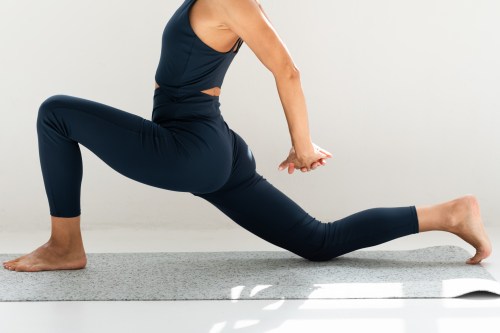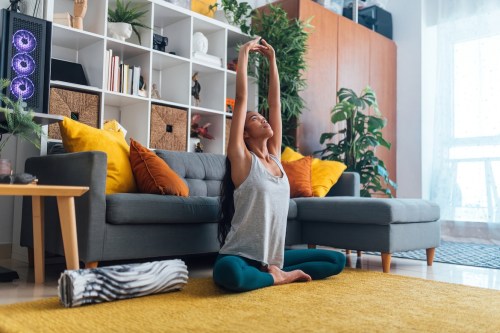Yoga’s good for you. There’s just no arguing with that. I tried resisting the practice for so long in favor of more high-intensity, sweat-packed workouts, until I was pushed into a class. It only took a couple of downward-facing dogs for me to realize that I was going to get hooked. If you’ve done yoga, I’m sure you feel me when I say that the practice has undeniable mind and body benefits.
One of the reasons why I was so hesitant to dive in was that I thought that it wasn’t a good way to get my sweat in. I like to feel beat up and sore after a workout. But the effects of yoga are so much greater—and so much deeper—than merely being a form of exercise. In fact: It can help you change your body at a cellular level to help make more space. Here’s what’s behind that.
What is happening on a cellular level
Yoga makes your entire body more balanced overall. “From a musculoskeletal perspective, your body is made up of trillions of cells that get organized in a variety of ways, which then become tissues, which then become organized and become organs, which then become systems,” says Lara Heimann, a certified physical therapist and yoga expert. “The bulk of the day does not require a variety of movement, so that inevitably leads to imbalance, meaning that you’ll have some tissues that are shortened or restricted while some are not. And all of your organs can be affected by poor posture. So a yoga practice will get things more balanced and bring balance to the tissues around your joints.” So when you’re feeling hunched over in your posture or restricted in your movements, movement through yoga frees up the tissue and makes it more pliable—which is why some say that yoga brings more “space” to the body.
And as it happens, the more-is-more philosophy kind of holds true with movement because “cells need balance which comes from movement. We’re 60 percent water, so a lot of our movement is performing a hydraulic effect that hydrates the tissues themselves so we don’t feel crinkly. That fluid in the joints and your spinal column are responsible for helping compressive forces with shock absorption. But when you have bigger joints like the hips, the shoulders, even down into the elbow and wrist—these are synovial joints, so synovial fluid is like your own WD-40. That’s why you feel better when you start moving—you feel less stiff and it really is changing the fluidity in the body.”
Yoga versus other exercise
All of this led me to wonder: How does yoga then vary from other forms of exercise? You’re moving when you run or spin or do burpees, after all, but Heimann says it’s definitely different. “Most other forms of exercise are going to have repetitive movement that’s usually in one or maybe two planes, and it will pull on some of the tissue around particular joints,” she explains. “So for instance running or biking involves moving in a forward and back plane, and your hips are moving. But people don’t move much in their hips and it’s not requiring large ranges of motion in a variety of ways.”
In fact, that single-plane motion can actually create a sort of imbalance in your body. “Movement is always better than not moving, but you have to add onto that because it could actually exacerbate the imbalances,” says Heimann. Makes sense, considering how tight your hips get from running, for example, or the inflammation that can spring up in your muscles from over-working them.
“A smart yoga class would recognize people are going to come in with inherent imbalances, and move in a variety of planes, forward, back, sideways, twisting, coming up and down off of the floor,” she says. “When that happens, the muscles are fired up to move, and the muscles attach to the bone, and they pull on the bones and that pulling creates a friction and that’s a physiological heat which is a good thing and creates potential for change.”
Heimann adds that your body can adapt to a certain movement, especially if it’s only pulled in one way—so yoga is of course pulling in a variety of ways. “So the heat creates a global change from all the different movement patterns,” she says.
The variety of movement patterns and planes are key because of the sedentary lifestyles some of us lead. “We really need to get expansiveness, and that has to come from this more global integration—because if you just stretch in the opposite direction it isn’t necessarily effective,” says Heimann. Instead, she suggests that the range of motion is the most important to create real, impactful alignment in the body. (This is one of the many reasons why yoga is so good for sleep.)
How to feel these changes
Since the changes from yoga are happening on a minute level, how will they even be perceptible to you? Heimann says you’ll just know. “There are a lot of people who can feel a change quite quickly if they are doing yoga regularly,” she says. “So like with three times a week, you’ll feel a difference by just feeling more space in your body. You get out of this feeling of being compressed.”
Besides that, Nathan Favini, MD, medical lead at Forward, adds that regular yoga affects the risk of heart disease, improves lower back pain, improves the quality of life in people with asthma, and reduces anxiety. “There are so many ways that yoga can noticeably improve your life,” he says, though he does note that a mix of resistance and flexibility training along with cardio will have a better impact on markers of longevity in your telomeres.
Of course, you can’t just take one yoga class a year and say you’ve done your cellular change work. “With anything that you want to change, you’ll have to do it overtime—to really fix imbalances, you’ll have to go three times a week to start really noticing the changes,” says Heimann. Regular yoga also brings more awareness to your body. “You’ll have a better sense of living in the body—you’re more tuned in,” she says. “We are a vibration of cells, and yoga is a tuning fork—it just tunes us up and we can feel it.”
Sign Up for Our Daily Newsletter
Get all the latest in wellness, trends, food, fitness, beauty, and more delivered right to your inbox.
Got it, you've been added to our email list.











